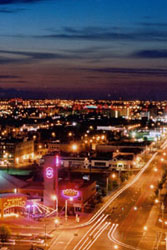Eco Architecture

by Ysanne Spevack
A ’sustainable city’ enables all citizens to meet their own needs and to enhance their well-being without damaging the natural world or endangering the living conditions of other people, now or in the future.
• Herbert Girardet
It’s the year 2012. The NASA space migration plan is in Phase One, but most of the people of Earth have made a commitment to stay on the blue green planet and care for their home. The regeneration program is led by the Old World where nothing is true and everything is permitted. The leading technologies being developed and put into practice were born at the end of the last century. The new black is ecotechture. Citizens live in cities of shining towers, shimmering in the sunlight of warmer days. These solar panelled habitats are topped with beautiful spiralling windmills. Rainwater is precious, so every tower is circled by a system of ducts which direct the rain to mix with the apartments’ waste water, to be recycled and used again. Refuse and human waste is processed deep in the foundations of each tower, producing far more energy than the towers consume. The excess energy is redirected to the city’s hospitals and community programs, permaculture units and pleasure gardens. Fuel cell cars travel the city’s extensive subway system, processing hydrogen into waste water vapour.
Nobody needs to leave their apartments for practicalities. Although anachronistic stores continue to peddle desirables, most goods are bought over the internet and delivered by droid. The only packaging options are environmental, the only viable products eco-friendly. People leave their towers for pleasure and communion with other citizens. Great public amphitheatres offer free arts and entertainment of every style. Whilst away from their homes, citizens adjust and interact with their homes using their cellphones and bluetooth technologies. Whilst at the amphitheatre, a citizen can direct their home’s hot water system to pour a bath and a cup of tea ready for their return.
True democracy has finally been put in motion, with live debates and voting procedures electronically enabled by new email secrecy technology. The old dinosaurs of industry have been transformed by people of conscience inside each institution and by consumer pressure. BP has ditched its fossil fuel arm to concentrate and nurture its more lucrative sustainable fuel programs.
Doctors are practitioners of science and shamanism. Their holistic practices incorporate magic bullets and post-laser surgery, non-denominational spiritual healing and new-fashioned herbalism, energy stimulation techniques and understanding. People are healthier as everybody eats organic food either from the countryside or from the city’s permaculture sites. With all traffic removed from the streets, citizens have remembered the pleasures of walking the green lanes and cycling to their destinations. Stress levels have been equalised by the more moderate pace, and children are able to play in the streets.
This vision is not so far-fetched. There are people working towards this vision, wheels set in motion. In an unlikely neighbourhood of London, this vision is about to become a reality. Elephant and Castle is a deprived inner city area in South East London. It is currently known for its extensive triple carriageway double roundabout system, its ugly concrete shopping mall, and a concentration of crime-generating soul-destroying architectural mistakes of the 1960’s and 1970’s. It is also set to host the biggest environmental regeneration programme in the history of Europe.
The £1 billion regeneration of the shopping mall and surrounding area in central south London will cover 170 acres. The new Elephant & Castle will include 1m square ft of retail and leisure space as well as 3.5m sq ft of housing and 850,000 sq ft of work/live, key worker and office space. The project will be a significant demonstration of the UK Government’s commitment to sustainable development, encompassing key principles of the Urban Task Force document by Lord Richard Rogers.
Battle McCarthy Consulting Engineers are responsible for developing the Sustainable Masterplan and Building Technology for the redevelopment of the Elephant & Castle. They are working alongside a team of architects and engineers called Southwark Land Regeneration Plc. SLR is a joint venture company between Godfrey Bradman and his associates, Frogmore Estates Plc and were chosen from three short-listed developers. The design team for the project is led by Masterplanners, KP Architects and includes: Foster & Partners, Ken Yeang, Derek Lovejoy Partnership, HTA Architects Ltd, Benoy Architects, Halcrow Transport Engineers and Battle McCarthy Consulting Engineers & Ecologists. All were chosen for their particular design expertise.
Under the leadership of Nicholas Taylor from SLR, the design team will create the groundbreaking 21st century “greenprint” for an ecological urban centre. Battle McCarthy are responsible for the Sustainable Masterplan that will make major environmental improvements to the surrounding area in preparation for the essential reconstruction of the central core. Principal ecological enhancements include an eco-park on the roof of the new shopping centre, a new London Square and pedestrian-orientated green lanes throughout the development. On previous projects, Battle McCarthy have established partnerships with leaders in industry to create a practical framework for sustainability. This includes working with Thames Water to reduce water consumption as well as working with utility companies to create zero CO2 emissions energy supply. In partnership with Corus (British Steel) and British Telecom, the practice has developed a building technology for the project that will meet the changing needs of residents. They have developed a unique housing idea around the idea of homes for life.
The new homes may be adapted to suit individual needs of the residents. Floors may be removed to link spaces, partitions may be added to isolate spaces, facades may be supplemented with balconies and conservatories, and roof spaces may be expanded when required. The building materials will have low embodied energy and come from sustainable material resources. All homes will be provided with information technology cabling and fitted with security sensors as well as systems for home health care services. These new building technologies will also provide employment and skill development opportunities for local people. This “greenprint” will build upon Battle McCarthy’s previous achievements in providing Sustainable Frameworks for Cambourne New Town, the Greenwich Peninsula and the neighbouring Millennium Village, a self-build Buddhist Retreat on Holy Island as well as many others.
In short, this means that the new homes will be a modern environmental spin on prefabricated homes from the post-war era. They will have huge environmental advantages. When a standard home is built, there is tremendous wastage. Wood is sawed to size, with any excess discarded. Skips of new materials are thrown away. With the new modular housing, wastage is minimised. Also, adding an extension is a simple job which takes only a few hours. Unlike the old prefabs, the new houses will be comfortable and well insulated for heat and noise. And some modular apartments will rise high into the sky forming architect Ken Yeang’s centrepiece, the Eco-Tower.
Sustainability is the new buzz-word rocking the world of architecture. A visit to the Royal Institute of British Architects’s bookshop revealed a whole section on environmental architecture and architectural engineering. Sustainability is the new white, and the UK is a leading nation in this new global movement.
Guy Lafayette is the driving force behind the Consultancy for Corporate Change based in London’s Southwark. Guy has a highly developed and integrated vision about sustainable business techniques. As well as acting as a communication consultant for eco-engineers Battle McCarthy, Guy and his team are actively working to ensure that sustainability in architecture and all forms of business is not a fad.
The CCC is a pool of new thinkers and management specialists including neuro-linguistic programming expert David Lee, Copenhagen-based Allan Hjorth, Vienna-based management training expert Martin Toffel, and a rosta of some of the most innovative movers and shakers in management training and sustainability. The CCC is an example of an international business sustainability movement including the Rocky Mountain Institute in Colorado. Established by Amory Lovins, the RMI exists to promote the reality that environmental sustainability makes financial sense. This is the basis of Lovins’ books Factor 4 and Natural Capitalism. In Japan, architect Kisho Kurokawa has developed his vision of the ‘eco-media city’ since 1960. He calls the current era the ‘Age of Symbiosis’, and draws on Japan’s rich heritage of Mahayan Buddhism from the 4th century to the present as inspiration for sustainable architecture. In the USA, economist Kenneth Boulding has been a guiding force having coined the phrase ‘Spaceship Earth’ in the early 1970’s. This concept is that from an economic and environmental viewpoint, we should view resources as finite, recycling them as the Earth is a closed unit like a spaceship.
I caught up with Guy Lafayette in Southwark, London, and asked him to tell me more about his business.
Consultancy for Corporate Change has been set up to find sustainable solutions to the changes that are sweeping our planet. Environmental, cultural and technological changes make it necessary for all levels of business, from SMB’s to global corporations, to have some kind of strategy in order to adapt and thrive.
The result could involve anything from creating a practical program to make your office more environmentally sound to developing strategies for manufacturing new products that run on renewable energies. We also provide management training skills to equip staff to meet the new sustainability criteria.
Sustainbility is about more than just efficient use of resources or securing a financial future. It is also about creative innovation, nuturing community and cultural evolution. It is necessary to take all of this into account and make change a creative and exciting venture that will challenge contemporary thinking. Scientists believe that our species only has another 50 years before we become extinct unless we make sustainability a priority now. I strongly believe that sustainable technology and holistic thinking will infiltrate our lives more than the computer.
An important route to greater sustainability in architecture is for the development of environmental building materials. One example of this is a new hemp product to replace conventional rockwool. The hemp wool is just as good for heat insulation as rockwool and lasts just as long, but is non-carcinogenic and very eco-friendly. Hemp actually puts more nutrients into the soil where it grows than it takes out, making it the greenest of all plants. The hemp wool has been developed by Derek Bielby at Hemp Union, a man who is passionate about hemp and the environment. The Building Research Establishment publishes a directory listing the greeness of different building materials, and Construction Resources is the DIY source of everything green, from house paints to flooring solutions.
Chris McCarthy of Battle McCarthy consulting engineers and landscape architects sees environmental building materials as crucial.
Engineering a sustainable future for our built environment is dependant upon engineers reducing material content of construction whilst increasing the performance of architecture in providing satisfaction for the occupier’s needs of the lowest possible capital and running cost. The manufacturing industry has a major part to play in modernisation of the construction industry and ensuring its product is adaptable to change.
The re-use of building components is the most cost effective and environmentally friendly form of construction. The global eco-architecture movement may consider reusable building systems with temporary, poor quality throwaway ‘Shanty Town’ architecture. Early traditional structures may seem more sustainable but often are not.
Watch this space…
Contacts
- Battle McCarthy
Tel: 020 7440 8282
www.battlemccarthy.demon.co.uk - Royal Institute of British Architects
www.living-city.net and www.riba.net - Hemp Union
Tel: 01482 225328
www.hemp-union.karoo.net - Construction Resources
Tel: 020 7450 2211
www.ecoconstruct.com - Building Research Establishment
Tel: 01923 664000
www.bre.co.uk - Gordon Clarke Architects
www.gcarchitects.co.uk
Like this page? Please link to us and let the world know!









